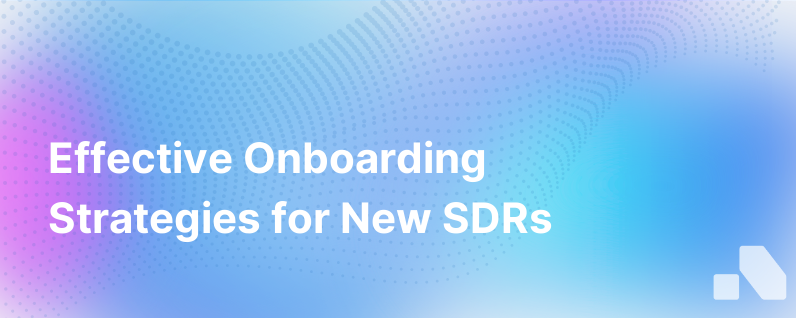
Onboarding Sales Development Representatives (SDRs)—those vital connectors between potential customers and the sales organization—is a make-or-break process for many businesses. In the fast-paced world of sales, it isn't just about getting these reps up and running; it’s about empowering them to deliver peak performance with confidence, knowledge, and skill.
Understanding that SDR onboarding is much more than a few days of orientation and shadowing is the first step towards building a high-performing sales team. In this guide, we'll uncover the critical components of successful SDR onboarding, from initial preparation to ongoing development and everything in between.
Establishing a Firm Foundation
Effective onboarding begins before the SDR even walks through the door. This proactive phase sets the tone for a structured, engaging learning experience.
Preparing for Success:
- Create a comprehensive onboarding plan tailored to the unique needs of your sales domain.
- Ensure that HR, IT, and sales managers are in sync, with seamless processes for setting up email accounts, software access, and workstations.
- Compile an onboarding package replete with product literature, competitor analysis, CRM tutorials, essential tools information, and a detailed schedule of the onboarding journey.
The First Week: Laying the Groundwork
The first week is crucial for imparting the core values of your company, aligning expectations, and building excitement about your product or service.
Week One Objectives:
- Introduce your company culture and values, emphasizing how SDRs contribute to overall goals.
- Begin product and service education. The SDRs should start to build out a solid understanding of what you offer and the problems it solves.
- Introduce the CRM and other sales tools, focusing on the fundamental functionality, as they will be using these daily.
- Pair the SDR with a mentor or buddy – someone who can provide guidance, answer questions, and offer insights into the company’s personalized sales approach.
Immersive Learning
Once the basics are in place, deep dive into the world of your product or service.
Product Proficiency:
- Detailed product demonstrations: Walk through features, benefits, and case studies.
- Hands-on experience: Provide product or service trials for SDRs to understand the customer's perspective.
- Learning by immersion: Engage SDRs in role-playing exercises that simulate typical buyer interactions.
Sales Process and Techniques
Understanding the sales process and mastering effective communication techniques is vital for SDRs to succeed.
Sales Mastery:
- Overview of the sales pipeline: Show how SDR efforts fit within the wider sales cycle.
- Training on prospecting techniques: Effective ways to generate leads and how to qualify them.
- Communication training: Written (email outreach) and verbal (cold calling) tactics, as well as active listening and objection handling.
Shadowing and Practical Experience
Theory is valuable, but there’s no substitute for practical, hands-on experience. Let SDRs learn from those on the front lines.
Real-World Learning:
- Shadowing sessions: Have new SDRs listen in on calls and meetings with experienced sales staff to see live action.
- Structured feedback: Following shadowing sessions, provide a safe environment for questions and detailed feedback.
- Gradual responsibility increase: Start SDRs with minor tasks and gradually increase their load as they get more comfortable.
Setting Targets and KPIs
Transparent goals and clear key performance indicators (KPIs) help new SDRs understand what is expected of them.
Goal Setting:
- Outline the role of KPIs in daily, weekly, and monthly goals.
- Review pipeline contribution expectations and the significance of lead quality over quantity.
- Establish a timeline for ramp-up quotas, allowing SDRs to grow into their full responsibilities.
Tools and Technology Proficiency
In the technology-fueled world of modern sales, SDRs must become adept at using various tools efficiently.
Technological Acclimatization:
- In-depth sessions on the CRM to understand tracking and documentation best practices.
- Introduce sales engagement platforms, showing how to automate and optimize communications.
- Mastery of research tools for leads and accounts, including Aomni-like AI platforms to gather actionable insights.
Continuous Development and Evaluation
The best onboarding programs perceive education as a continual journey, not a one-time event.
Ongoing Improvement:
- Regular one-on-ones to address challenges and discuss progress.
- Access to continued learning resources like webinars, workshops, and industry events.
- Regular role-playing and training sessions to keep sharpening sales skills.
The Aomni Difference
At the heart of an effective onboarding program is ensuring SDRs are equipped with the tools to help them succeed. Platforms like Aomni empower new SDRs by providing real-time account research and personalized sales content effectively—reducing the guesswork and the time-consuming aspects of their role.
With actionable competitive insights delivered in just 15 minutes, an SDR can swiftly match their newfound skills with in-depth knowledge, ensuring that even new team members can operate strategically from the get-go.
In Summary
A strategic, step-by-step onboarding process that encompasses company values, product knowledge, sales skills, and tool proficiency is essential to developing high-performing SDRs. Establishing regular check-ins and providing ongoing development opportunities will keep them growing and improving. And with the support of innovative tools like Aomni, their strategic selling abilities can truly flourish, translating to a more robust revenue pipeline and a higher level of job satisfaction.
Onboarding SDRs is not just an introductory phase; it’s an investment in the caliber and longevity of your sales team. With a methodical approach that values the individual’s growth and leverages technology, startups can build an SDR team that's agile, knowledgeable, and equipped to drive business success.